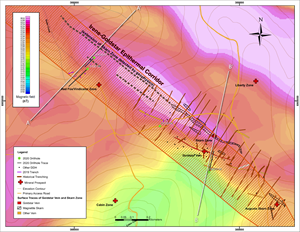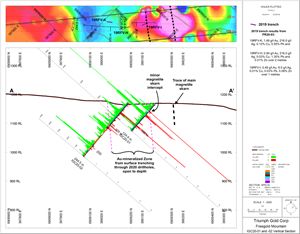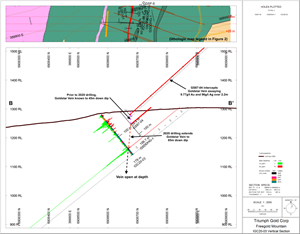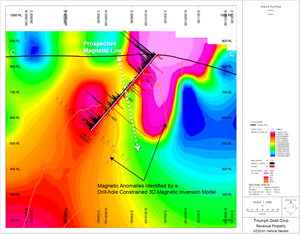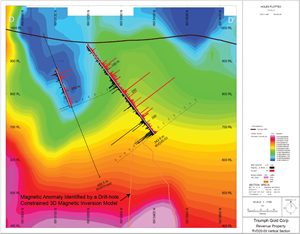Triumph Gold Announces 2020 Drill Results including Near-Surface Gold Discoveries and Extension of the High-Grade Goldstar Vein
VANCOUVER, British Columbia, Jan. 26, 2021 (GLOBE NEWSWIRE) -- Triumph Gold Corp. (TSX-V:TIG | OTCMKTS:TIGCF) (“Triumph Gold” or “the Company”) is pleased to announce drill results from their flagship Freegold Mountain Project located in Yukon’s Dawson Range Gold District. The 2020 exploration program was focused on drill testing near-surface gold targets in the Revenue-Nucleus and Mount Freegold areas (PR20-07). Nine holes were drilled for a total of 2,068.52 metres (Table 3).
“The 2020 campaign was small but successful, with all nine holes returning significant gold intercepts in untested or under-explored areas,” said John Anderson, Executive Chairman and CEO of Triumph Gold. “We are very happy with these discoveries that complement existing prospects and deposits of the Freegold Mountain Project.”
Technical Highlights1:
| • | Within the Irene-Goldstar Epithermal Corridor, 2020 drilling successfully tested the down-dip extension of the Goldstar Vein and validated the continuity of the system with long step-outs (up to 570 metres) into untested portions of the corridor intersecting multiple parallel gold-rich zones. Results include: | |||
| ° | Extension of the high-grade Goldstar Vein by over 85 metres down dip in IGC20-03 with | |||
| ° | 1.59 g/t Au, 96 g/t Ag, and 2.3% Cu over 1.56m (152.00 to 153.56m), including 4.59 g/t Au, 200 g/t Ag, and 6.9% Cu over 0.50m (153.06 to 153.56m) | |||
| ° | Extension of the Skarn Zone by 570 metres to the northwest in IGC20-01 with the intersection of near-surface high-grade gold and silver in massive magnetite assaying | |||
| ° | 1.12 g/t Au and 15.6 g/t Ag over 7.23m (27.82 to 35.05m), including 7.49 g/t Au and 37 g/t Ag over 1m (33.00 to 34.00m) | |||
| ° | Discovery of near-surface gold and silver rich zones in multiple holes along the Irene-Goldstar Epithermal Corridor including | |||
| ° | 0.89 g/t Au, 22 g/t Ag, and 0.17% Cu over 9.75m (48.16 to 57.91m) in IGC20-01, including 1.47 g/t Au, 35 g/t Ag, 0.23% Cu, 0.05% Pb and 0.11% Zn over 5.58m (49.18 to 54.76m), and | |||
| ° | 1.81 g/t Au and 8.6 g/t Ag over 7.62m (42.67 to 50.29m) in IGC20-02, including 2.87 g/t Au and 12 g/t Ag over 4.57m (42.67 to 47.24m) | |||
| • | In the Revenue-Nucleus Area, drilling outside of known porphyry copper-gold mineralization resulted in multiple intersections of greater than 1 g/t gold, as well as the discovery of gold within an oxidized zone in KZ20-02 with assays of: | |||
| ° | 0.82 g/t Au over 12.27m (1.45 to 13.72m), including 2.2 g/t Au over 3.12m from surface (1.45 to 4.57m), within a larger interval of porphyry-style gold and copper mineralization | |||
A video summary of today’s news release is available by clicking the following link:
2020 Exploration Highlights – Freegold Mountain Project
Details of Drill Results:
Irene-Goldstar Epithermal Corridor
Four drill holes, totalling 555.18 metres (Table 3), were drilled in the Mount Freegold area during 2020 exploration. Three of the four holes collared in previously undrilled portions of the Irene-Goldstar Epithermal Corridor, a 3.7 kilometre long zone of gold and silver rich epithermal and skarn mineralization associated with a major splay of the Big Creek Fault (first outlined in PR20-03).
Mineralization within the Corridor (Figure 1) was first identified near Mount Freegold in 1930 with erratic but significant gold-rich intercepts of the Skarn Zone (e.g. chip samples that returned up to 366 g/t Au and 106 g/t Ag over 5 metres) and the Goldstar Vein epithermal system. In 1989 C. A. Main estimated a mineral inventory for the Goldstar Vein at 123,000 tonnes of 4.21 g/t Au and 47.2 g/t Ag contained within a shallow pit approximately 250 metres long by 60 metres deep2. Prospecting 2.5 kilometres to the northwest of the Goldstar Vein led to the discovery of the Irene Vein in 2013, and inaugural drilling of the vein in 2018 outlined a mineralized strike length of at least 450 metres, with grades of up to 20.7 g/t Au over 0.70m (PR19-02). Limited prospecting and trenching between the Goldstar Vein and Irene Zone resulted in significant grab (e.g. 425 g/t Au and 321 g/t Ag) and chip sampling from trenches (e.g. 3.85 g/t Au and 103 g/t Ag over 2m) at the Red Fox/Vindicator Zone, strongly indicating continuity of this mineralized trend.
The 2020 drill program along the Irene-Goldstar Epithermal Corridor successfully tested the down-dip extent of the Goldstar Vein and demonstrated continuity of both skarn and epithermal vein styles of mineralization within the 2.5 km-long previously undrilled portion of the corridor.
Drill hole IGC20-03 tested beneath the known extent of the Goldstar vein and intersected 1.59 g/t Au, 96.04 g/t Ag, and 2.28% Cu over 1.56m at 152 metres depth extending the Goldstar Vein by at least 85 metres down dip (Figure 4). This intercept demonstrates continuity of the high-grade vein to depth, and presents an immediate opportunity for resource definition work along the Corridor.
Drill holes IGC20-01 and IGC20-02 form a fence across the Irene-Goldstar Epithermal Corridor at the Red Fox/Vindicator Zone and successfully extend gold, silver, and base metal mineralization within the corridor by at least 570 metres along strike from the nearest drill hole at the Goldstar Vein (Figure 2). IGC20-01 intersected massive magnetite at 33 metres depth, assaying 7.49 g/t Au and 37 g/t Ag over 1 metre, while testing a moderate magnetic response along the flanks of a prominent 870 metre magnetic not tested by drilling in this area (Figure 3).
Additional intersections of new epithermal gold and silver mineralization in all four 2020 drill holes support continuity of both gold-rich skarn and epithermal vein mineralization within the Corridor (e.g. values up to 2.87 g/t Au and 12.33 g/t Ag over 4.57m in IGC20-02). IGC20-04 also identified epithermal mineralization, returning 1.14 g/t Au and 10 g/t Ag over 1.02m, but terminated prematurely due to a catastrophic drill failure at the end of the program.
Of the 3.7 kilometre length of the corridor, less than 2 kilometres have currently been tested by drilling. Inaugural drill testing at the Red Fox/Vindicator Zone is strong evidence for continuity of mineralization through the entire corridor. Work in 2020 also included updating infrastructure in the area, which will allow for efficient access to untested portions of the corridor in 2021.
Table 1: Highlighted 2020 drill results from the Irene-Goldstar Corridor (Mount Freegold Area)
https://www.globenewswire.com/NewsRoom/AttachmentNg/bad4c204-ab4b-491f-a78c-0183b29edc15
Jesse Halle, Vice President of Exploration for Triumph Gold commented, “Multi-gram gold and silver results from the southeastern and central portions of the Irene-Goldstar Epithermal Corridor provide ample incentive to continue exploration and definition of this long and fertile mineralized system. Elsewhere in the corridor, increased drill density has been the key to identifying higher grade sections of the system – with recent compilation and 3D modelling we are now able to explore more effectively and efficiently than ever before.”
Revenue-Nucleus Area
Five drill holes totalling 1513.34 metres were completed in the Revenue-Nucleus area during 2020 exploration (Table 3). The Revenue-Nucleus Area is defined by a 6 kilometre long intense soil geochemical anomaly related to widespread porphyry copper-gold and associated epithermal mineralization. Since 2017, renewed focus on the area has resulted in multiple discoveries including the high-grade Blue Sky and WAu Breccias.
2020 exploration resulted in multiple mineralized drill intersections in the Revenue-Nucleus Area (Table 2) including highly anomalous gold related to newly discovered structures at the Keirsten Zone in KZ20-01, previously unidentified gold enrichment in an oxidized horizon from surface (within a broader interval of highly-anomalous gold and copper) at Keirsten South in KZ20-02, and multiple intersections of over 1 g/t gold at Revenue East in RVD20-02 and RVD20-03.
Table 2: Highlighted 2020 drill results from the Revenue-Nucleus Area
https://www.globenewswire.com/NewsRoom/AttachmentNg/55d5cb64-0a6d-4ee9-8999-a7f8d2380e47
Keirsten Zone and Keirsten South
Two holes were drilled in the Keirsten area during the 2020 exploration season (Figure 5). KZ20-01 was designed to target strong coincident chargeability and magnetic geophysical anomalies in the Keirsten Zone, highlighted by a new Drillhole-Constrained 3D Magnetic Inversion Model. The drillhole intersected altered granodiorite and porphyritic dykes, with a structurally-controlled, weak to moderate oxide overprint persisting to 175 metres depth. Modelled magnetic geophysical anomalies were supported by observed magnetics in drill core resultant from anomalous concentrations of pyrrhotite and primary magnetite. Gold mineralization increased between the magnetic anomalies, within a faulted domain host to various porphyritic dykes, returning values up to 1.37 g/t Au over 1.27m (Table 2). This highly prospective, over 500 metre long structural-magmatic corridor stands out as a broad magnetic low (Figure 6) not previously tested by drilling, despite being coincident with significant Cu and Au in soil anomalies.
KZ20-02 was drilled a kilometre south of KZ20-01 and was designed to explore a 400 metre wide by 400 metre long gold and copper geochemical anomaly. The hole encountered a zone of iron oxidation returning gold grades of 2.2 g/t Au from 1.45 to 4.57 metres (Table 2), and elevated gold to 16.76 metres. Pervasive iron oxidation extends to approximately 40 metres downhole but persists to 110 metres as moderate to locally intense patches. Assays from this interval yielded 0.3 g/t AuEq3 over 87 metres from top of hole (Table 2). This drillhole intersected clay-altered monzonitic to monzodioritic rock with quartz veins and local feldspar porphyry dykes to approximately 230 metres depth where it penetrated Yukon Tanana country rock. Gold, copper and molybdenum were highly-anomalous throughout the hole indicating proximity to a porphyry-related mineralizing system.
Brian Bower, Lead Technical Director for Triumph Gold added, “The intersection of highly-anomalous gold in this area makes Keirsten South an exciting new zone warranting more exploration. The technical team is reviewing spectral data to determine alteration zonation and is now modelling the oxidation surface to determine the oxide gold potential of the area.”
Revenue East
Revenue East is approximately 250 metres east of the high-grade gold and copper Blue Sky and WAu Breccias and is defined by an over 400 metre long gold, copper, and bismuth geochemical anomaly. Three drill holes were completed in the area during the 2020 exploration program, all confirming widespread gold mineralization in the area. Visible gold and bismuthinite were identified in drill core from RVD20-01 and RVD20-02 (Figure 5) and elevated gold grades of up to 1.64 g/t Au over 1 metre were intersected (Table 2). Results confirm that the geochemical anomaly is in-situ and is an effective vector to subsurface mineralization.
RVD20-03 (Figure 5) was designed to test another geophysical anomaly identified by the Drillhole-Constrained 3D Magnetic Inversion Model. Drilling confirmed a magnetic body immediately following a shear zone at approximately 275 metres depth (Figure 7). The drill hole contained visible gold and bismuthinite associated with quartz-carbonate veining, as well as long intervals of anomalous gold and copper, locally returning grades up to 1.51 g/t Au over 2 metres (Table 2). The anomalous magnetic target was encountered where expected providing additional support to the accuracy and predictability of the 3D magnetic inversion model.
Table 3: Drill Hole Locations and Orientations4
https://www.globenewswire.com/NewsRoom/AttachmentNg/76d5b018-093c-4e65-955e-eb1078bf2264
COVID-19 Response
Triumph Gold is committed to the health and safety of its employees and contractors. With recommendations from the Yukon Government and Yukon Chamber of Mines, the Company developed and implemented infection prevention and control measures at the Freegold Mountain Project to help reduce and minimize the risk of potential COVID-19 transmission in the camp and related work sites. During the 2020 field campaign, employees, contractors, and visitors were regularly monitored for symptoms and required to adhere to federal and territorial regulations, as well as Company prevention policies outlined in the Triumph Gold Corp COVID-19 Operational and Emergency Response Plans. Visitors and cross-shifts were not permitted during the field program, and camp employees and service providers were sourced from Yukon, with the exception of Triumph Gold corporate management who strictly followed regulations and guidelines upon entering the Territory.
Sampling Methods and Qualified Person
Drill core samples ranged between 0.5 and 2 metres length and were cut at Triumph Gold’s core logging facility at the Freegold Mountain Project. The samples were analyzed by SGS Canada of Vancouver, British Columbia. They were prepared for analysis according to SGS method PRP89: each sample was crushed to 75% passing 2mm and a 250g split was pulverized to better than 85% passing 75 micron mesh. Gold was tested by fire assay with atomic absorption finish on a 30g nominal sample (method GE_FAA30V5), and samples that tested over 10 g/t Au were retested using a 50g sample and a gravimetric technique. Additional 33 elements were tested by ICP-AES using a four-acid digestion (method GE_ICP40Q12), over-limit samples for copper were retested using the same technique, but with ore grade four acid digestion and a higher range of detection (method GO_ICP42Q100). Quality assurance and control (QAQC) is maintained at the lab through rigorous use of internal standards, blanks and duplicates. An additional QAQC program was administered by Triumph Gold: A minimum of three quality control samples, consisting of blanks, certified reference standards and duplicates, are blindly inserted into each 75 sample batch. QAQC samples that return unacceptable values trigger investigations into the results and reanalysis of samples that were tested in the batch with the failed QAQC sample.
The technical content of this news release has been reviewed and approved by Jesse Halle, P.Geo., Vice President Exploration for the Company and qualified person as defined by National Instrument 43-101.
Notes
| 1 | Reported assays are uncut length-weighted averages and represent drilled core lengths. The true width of reported mineralization is unknown. |
| 2 | C.A. Main (1989) estimate should not be relied upon, as a Qualified Person has not done sufficient work to classify the estimate as a current mineral resource. |
| 3 | Gold equivalent [AuEq] is used for illustrative purposes, to express the combined value of gold, silver, copper, molybdenum, and tungsten as a percentage of gold for the Revenue-Nucleus area (porphyry related) and gold, silver, copper, lead, and zinc as a percentage of gold for the Mount Freegold Area (epithermal related). The lower detection limit for silver in assay package GE_ICP40Q12 is 2 g/t, therefore any samples that returned <2g/t have been excluded from all AuEq calculations. No allowances have been made for recovery loss that would occur in a mining scenario. AuEq is calculated on the basis of US$1,500 per troy ounce of gold (Au), US$18.00 per troy ounce of silver (Ag), US$3.00 per pound of copper (Cu), US$9.00 per pound of molybdenum (Mo), US$1.00 per pound of lead (Pb), US$1.25 per pound of Zinc (Zn), and US$13.00 per pound of tungsten (W). |
| 4 | Table coordinates presented in NAD83 (Zone 8N); Azimuths presented relative to UTM Grid. |
About Triumph Gold Corp.
Triumph Gold Corp. is a Canadian based, growth-oriented gold exploration and development company with a district scale land package in mining friendly Yukon. The Company’s 100% owned, road accessible, flagship Freegold Mountain Project is located in the Dawson Range and is host to three NI 43-101 Mineral Deposits. The Project covers an extensive section of the Big Creek Fault zone, a structure directly related to epithermal gold and silver mineralization as well as gold-rich porphyry copper mineralization. The Company, led by an experienced management team, is focused on creating value through the advancement of its strategic “gold first” exploration program. For more information, please visit triumphgoldcorp.com.
On behalf of the Board of Directors
Signed “John Anderson"
John Anderson, Executive Chairman and Interim CEO
| For further information please contact: John Anderson, Executive Chairman Triumph Gold Corp. (604) 218-7400 janderson@triumphgoldcorp.com | Nancy Massicotte IR Pro Communications Inc. (604) 507-3377 nancy@irprocommunications.com |
Mars Investor Relations (647) 557-6651 tig@marsinvestorrelations.com |
Neither the TSX Venture Exchange nor its Regulation Services Provider (as that term is defined in policies of the TSX Venture Exchange) accepts responsibility for the adequacy or accuracy of this release.
This news release contains forward-looking information, which involves known and unknown risks, uncertainties and other factors that may cause actual events to differ materially from current expectation. Important factors - including the availability of funds, the results of financing efforts, the completion of due diligence and the results of exploration activities - that could cause actual results to differ materially from the Company's expectations are disclosed in the Company's documents filed from time to time on SEDAR (see www.sedar.com). Readers are cautioned not to place undue reliance on these forward-looking statements, which speak only as of the date of this press release. The company disclaims any intention or obligation, except to the extent required by law, to update or revise any forward-looking statements, whether as a result of new information, future events or otherwise.
Figure 1: Plan Map of the 3.7 kilometre long Irene-Goldstar Epithermal Corridor (outlined in red hatch) located in the Mount Freegold Area between the Tinta Hill and Revenue Deposits.
https://www.globenewswire.com/NewsRoom/AttachmentNg/9b200a50-0253-4139-b8bc-6b8fdfd0e363
Figure 2 (Inset Map from Figure 1): Four holes were drilled in the southeastern portion of the Irene Goldstar Corridor during the 2020 exploration program: IGC20-01 intersected gold-rich massive magnetite skarn near surface, as well as zones of related epithermal Au-Ag (+/-Cu-Pb-Zn) mineralization; IGC20-02 intersected new, near-surface zones of epithermal Au-Ag (+/-Cu-Pb-Zn) mineralization; IGC20-03 extended the Au-Ag-Cu rich Goldstar Vein plus intersected new epithermal Au-Ag mineralization near surface; IGC20-04 terminated prematurely due to a catastrophic drill failure at 7.35m, but intersected high-grade gold and silver near surface.
https://www.globenewswire.com/NewsRoom/AttachmentNg/8130f091-2c6f-48ba-98d8-05cf71718cf7
Figure 3 (Cross-Section A to A’ from Figure 2): Cross-section through IGC20-01 and IGC20-02 displaying high grade gold and silver related to massive magnetite of the oxidized Skarn Zone at approximately 30 metres depth in IGC20-01, as well as newly drilled gold, silver, and base metal mineralization within the Irene-Goldstar Corridor in both IGC20-01 and IGC20-02.
https://www.globenewswire.com/NewsRoom/AttachmentNg/350d7e88-c9a0-4f72-b2dc-5f43160d010d
Figure 4 (Cross-Section B to B’ from Figure 2): Cross-section of IGC20-03 with epithermal gold and silver mineralization near surface and intersection of the high-grade Au-Ag-Cu Goldstar Vein, over 85m below its known extent, seen in drill hole GS87-04 at approximately 45 metres depth.
https://www.globenewswire.com/NewsRoom/AttachmentNg/1a1a5285-d421-4a04-a473-f521eba9753c
Figure 5 Plan Map of the Revenue-Nucleus Area. During the 2020 exploration program, two drill holes were completed in the Keirsten area (KZ20-01 and KZ20-02) and three holes were completed in the Revenue East area (RVD20-01, RVD20-02, and RVD20-03).
https://www.globenewswire.com/NewsRoom/AttachmentNg/d72d5bf3-c81b-48f6-9b95-bcae4675cb73
Figure 6 (Cross-Section C to C’ in Figure 5): Cross-section of KZ20-01 displaying measured down hole magnetic susceptibility in black and gold grade in red. Two magnetic anomalies were identified in the Keirsten Zone by a Drill-hole Constrained 3D Magnetic Inversion Model (outlined in orange). The anomalies were found where expected, bound by significant fault structures. Mineralization increased between anomalies.
https://www.globenewswire.com/NewsRoom/AttachmentNg/0b9185d8-7d0d-48e0-b9a3-ba5267bcf9f9
Figure 7 (Cross-Section D to D’ in Figure 5): Cross-section of RVD20-03 displaying measured down hole magnetic susceptibility in black and gold grade in red. The magnetic anomaly identified by the Drillhole-Constrained 3D Magnetic Inversion Model (outlined in orange) was intersected where expected, after a significant fault structure at approximately 275 metres downhole.
https://www.globenewswire.com/NewsRoom/AttachmentNg/c9b68c0f-9e87-40cf-98ae-ec7c64e0a045




